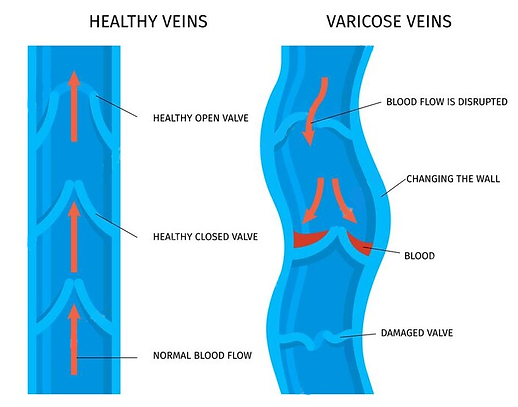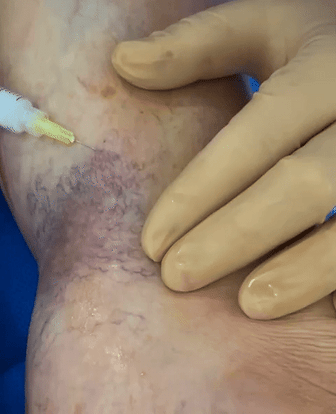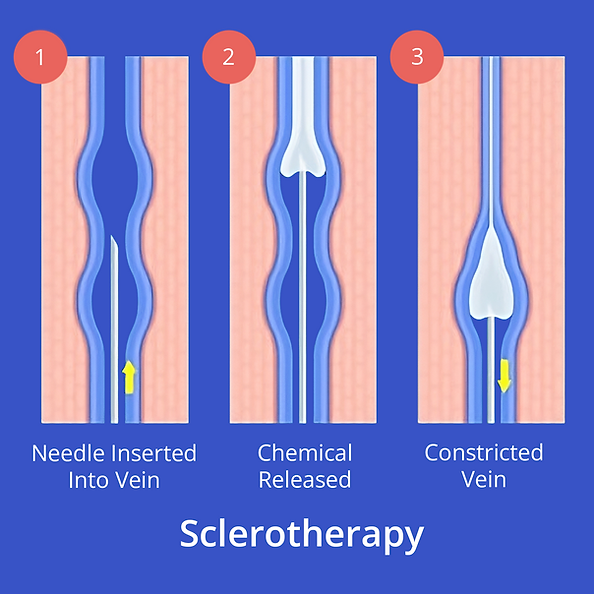Varicose Veins
What are they?
The leg veins carry blood away from the feet and up against gravity towards the heart. In an upright standing position, the blood will tend to cumulate in the calves. While walking, the pumping action of the foot (foot pump), calf muscle (calf pump) and the contraction of thigh muscles (thigh pump) will pump the blood up in the deep veins of the legs.
There are one way valves in the veins that pump blood towards the heart - when the valves malfunction or leak the blood can be propelled the wrong way from the deep to the superficial system where reflux occurs and varicose veins can develop. The blood may spill backwards down towards the feet again. This may cause the veins to enlarge. These enlarged veins are called "varicose veins". They are distended, being filled with accumulated, stagnant blood.
Varicose veins can be visible or hidden. The extent of the problem is best determined through an ultrasound examination. Stagnant blood can lead to complications in the skin, from eczema, discolouration, skin hardening and ulceration.

Symptoms, Causes and Treatment
Symptoms of Varicose Veins
Several symptoms can occur, especially after prolonged standing or at the end of the day.
-
Aching
-
Itch
-
Throbbing
-
Leg heaviness
-
Restless Legs
-
Cramps
-
Leg Swelling
Causes of Varicose Veins
Venous disease is common and affects men and women of all ages.
-
Family history - Some people inherit veins that are more likely to deteriorate.
-
History of DVT- If you have suffered from previous DVT’s there is a higher risk of developing varicose veins due to damaged valves.
-
Pregnancy- Due to hormonal changes and an enlarged uterus, this may restrict blood flow from the legs.
-
Obesity
-
Prolonged standing
-
Previous bone fractures and soft tissue trauma.
Diagnosis:
After history and examination, colour flow duplex ultrasound is the key diagnostic test for varicose veins.
Treatment Options Available
There are several treatment options available for varicose veins. As varicose veins serve no useful function they can be closed down without any harm, this will in fact improve the blood circulation. Successful treatment will relieve many of the symptoms.
-
Thermal Ablation: Endovenous laser therapy (EVLT) or Radiofrequency
-
Ultrasound Guided Sclerotherapy (UGS)
-
Direct vision sclerotherapy
-
Conservative management and compression therapy
It is important to understand that varicose veins can be a progressive condition and that new veins can develop with time. Ongoing maintenance treatment may be necessary for some patients.
What is Endovenous laser therapy?
Endovenous Laser Therapy (EVLT) is a technique used for the treatment of varicose veins. It treats the vein directly without the need to remove, using a laser fiber inserted directly into the vein(s).
What Vein is usually targeted during EVLT?
Only the superficial venous system is treated during EVLT – The superficial system is made up of two main veins: The Great Saphenous Vein and The Small Saphenous Vein.
Any accessory veins will also be treated.
Once these veins are closed, the remaining varicosities are closed using EVLT or foam sclerotherapy - your doctor will decide depending on vein size and location.

Treatment Process
-
First Appointment: Consultation – Patient history, examination and ultra-sound scan
-
Second Appointment: Endovenous laser ablation and/or Ultrasound guided sclerotherapy
-
Third Appointment: Review - Any residual veins are treated in clinic by Ultra-sound guided sclerotherapy.
OPTIONAL:
Micro-Sclerotherapy - Spider Veins are treated when all underlying “feeder” veins are closed.
Multiple treatments may be required depending on the severity of the spider veins.
What happens to the blood flow after EVLT?
Ablation of the treated vein stops the backflow of blood, this is then propelled back to the heart in line with normal physiology.
How long does the procedure take?
The procedure takes approximately half an hour per treatment, depending upon the complexity and severity of your veins.
What are the steps involved?
1. Ultra-sound guidance is used to identify the target vein.
2. The skin is numbed with local anaesthetic.
3. A fine catheter is guided into the vein.
4. Once access is gained, a laser fiber is teased into the target vein.
5. The procedure is performed with local anaesthetic, this requires several injections in the leg along the pathway of the vein. (A cold spray will be used prior to any
injection to reduce any discomfort).
6. Heat from the laser fiber will ablate the inside of the target vein and is slowly
withdrawn. This may last a few minutes. This processed is repeated if necessary.
What happens after the procedure?
The Nurse will apply a compression stocking/bandages to the leg at the end of the procedure. You will need to wear the stocking for 7 days in total, initially for 3 days and nights, reducing to day time only for the next 4 days.
After-Care
(3-9 days post procedure)
-
Hard lumps may develop up to 10 days after the procedure and may become red and tender.
-
Aching or pain may be experienced along the pathway of the vein.
-
A sensation of tightness along the pathway of the vein may occur. These areall normal inflammatory responses and can last up to two weeks. If this pain is severe, take NSAIDS, apply compression and moisturize the skin.
-
Bruising to the treated area can range from very little to extensive depending on the severity of the varicose veins treated.
Are there any risks with this procedure?
-
Rare side effects are skin discolouration or thermal injury to neighbouring tissues that might cause skin erythema (reddening) or neuropraxia (‘pins and needles’ sensation) in the leg, which recovers over time.
-
There is a risk of infection of the leg or deep vein thrombosis (DVT) - or clotextremely rare.formation in the major veins of the leg. The actual incidence of these problems are
-
As with all procedures there is a risk that the treatment will not be a success, although this is uncommon.
How long to resume normal activities?
-
Normal activity can resume as soon as possible.
-
Hot baths and vigorous activity such as gym workouts should be avoided in the first week after treatment.
-
Paracetamol can be taken for pain or NSAIDS (ibuprofen) to reduce any discomfort following treatment. Pain and discomfort for most patients is minimal and usually improve within a few days, but it can last for longer depending on the severity of the veins.
-
Flying and excessively long journeys should be avoided for the first week due to a slightly increased risk of deep vein thrombosis (DVT).
What are the advantages?
-
No general anaesthesia is required.
-
No cut is required to the groin.
-
The procedure is less painful than surgery.
-
Time to return to normal activity is much quicker than surgery -no down-time required.
Will I need to come back to hospital for a check up?
-
A follow-up appointment within 2-4 weeks after your treatment will be made for you. At this follow-up, the success of the treatment will be checked and further treatment may be required at this appointment.
Most patients will require further treatment for their varicose veins in the form of injection sclerotherapy. This is carried out in the clinic during your review.
What are the long term results?
-
The early results of this treatment are extremely good. More than nine out of ten patients treated have a good result and would recommend it to others.
Can I Drive on the day of my procedure?
-
Yes you can drive once you feel comfortable to do so as this procedure is carried out under local anaesthetic only.
-
When requested, sedation may be prescribed, on these occasions a chaperone is required to drive you home.
When can I exercise?
-
You can continue normal activities, please avoid high intensity exercise for 1 week after each treatment.
Spider Veins
What are they?
Spider veins or thread veins, also known as telangiectasias, are small, twisted blood vessels that are visible near the surface of the skin. They typically appear red, blue, or purple and most often develop on the legs or face. They get their name from their resemblance to spiderwebs. Spider veins are usually harmless and don't cause any health problems. However, some people may find them unsightly and choose to have them treated for cosmetic reasons.

Treatment for Spider Veins
Sclerotherapy
Sclerotherapy is a medical procedure used to treat varicose veins and spider veins, which are dilated and visible veins often found on the legs. The procedure involves injecting a solution (sclerosant) directly into the affected veins, causing them to shrink, close off, and eventually be reabsorbed by the body. This helps improve blood circulation by redirecting blood flow to healthier veins.

How does it work?
The sclerosant solution inflames the lining of the vein, leading to the formation of scar tissue. This scar tissue eventually closes the vein, causing it to collapse and fade from view. Over time, the treated vein is absorbed by the body, and blood flow is rerouted to other healthier veins.
Sclerotherapy is a minimally invasive procedure and is often performed on an
outpatient basis. It is commonly used to alleviate the symptoms of varicose veins and spider veins, such as pain, discomfort, swelling, and cosmetic concerns. The procedure may require multiple sessions to achieve the desired results, depending on the extent of the vein problem.

Sclerotherapy works by causing controlled damage to the walls of the targeted varicose or spider veins and triggering a healing response that eventually closes off and eliminates the treated veins. (Sclerotheapy may be used in conjunction with Endovenous Laser Ablation (EVLA) to treat veins that are not suitable for laser).
Treatment Process
What are the steps involved?
1. Injection: During the procedure, the patient is usually lying down. A fine needle is inserted into the targeted vein, and a sclerosant solution is injected directly into the vein. The solution irritates the inner lining of the vein, causing it to swell and stick together.
2. Compression: After the treatment, the doctor may apply compression through a bandage or compression stocking to help keep the treated vein walls in contact. This pressure helps to promote the closure of the vein.
Healing Process
Over the next few weeks, the injected vein begins to undergo changes. The
irritation caused by the sclerosant solution leads to the formation of scar tissue along the vein's inner lining. This scar tissue gradually closes off the vein, causing it to collapse and become sealed shut.
As the vein closes, the body's natural processes work to break down and
absorb the sealed vein. Blood flow is redirected to healthier veins nearby.
Over time, the treated vein fades from view and is no longer visible on the surface of the skin. Any associated symptoms, such as pain, swelling, or discomfort, may also improve.
Follow-Up
Multiple sclerotherapy sessions may be necessary to achieve optimal results,
depending on the severity of the condition and the specific veins being treated. Follow-up appointments with the doctor will be scheduled to monitor progress and determine if additional treatments are needed.